Many women examine their breasts in the fear of discovering a lump. Since one woman out of nine will develop cancer in her lifetime, what do you need to do to minimize cancer risk?

The "breast awareness" approach
Breast cancer is a serious disease that unfortunately affects too many women. It is the leading cancer among women. Breast cancer screening is performed mainly with mammography; however, if you know your breasts well, you’ll notice if something changes.
The Canadian Breast Cancer Foundation encourages women and men to use the "breast awareness" approach. While less frequent among men, breast cancer affects both women and men. As a result, men and women of all ages should know how their breasts normally look and feel. This helps them notice unusual changes more easily. This is a way of taking an active part in your own health and being better aware of your own body. This approach is not purported to be a method for saving lives or reducing the probability of dying from cancer; instead, it is recommended as a way of taking charge of your health.
How to examine your breasts
Everyone can adopt the "breast awareness" approach. There is no specific technique to follow: you simply choose the manner that suits you best. There is no right or wrong time for examining your breasts: you can do it whenever you like. You can examine your breasts by gently kneading them with your fingertips in a circular motion, moving from the chest wall to the nipple. Don’t forget to examine your underarms and the areas above and below each breast. Become aware of the way your breasts look and feel.
Normal changes
Women’s breasts change over the course of time, and some of these changes are quite normal. For example, when breasts develop at adolescence, bumps may form. This is normal. Pain in the breasts is also common during the menstrual cycle. During pregnancy, breasts change as they prepare for breastfeeding, become larger and more sensitive. Breastfeeding is also a period during which breasts change. At the end of the breastfeeding period, breasts may continue to secrete a little liquid. Finally, after menopause, breasts can change in size, shape, and become less firm.
Changes to watch for
If you are aware of your breasts’ normal state, you’ll be able to detect any unusual changes more easily. When you examine your breasts, watch for the following potential changes:
- Change in size or shape
- Abnormal or persistent pain in the breast or underarm
- Swelling around the underarm or below the collarbone
- Change in skin texture (wrinkles, folds)
- Change in the nipple (secretion, redness, crusting)
If you note a change that worries you, talk to your physician.
Now that you are familiar with the "breast awareness" approach, talk to family and friends about it and encourage men and women to adopt it. The health of your breasts is important to you, so be sure to be breast-aware!
